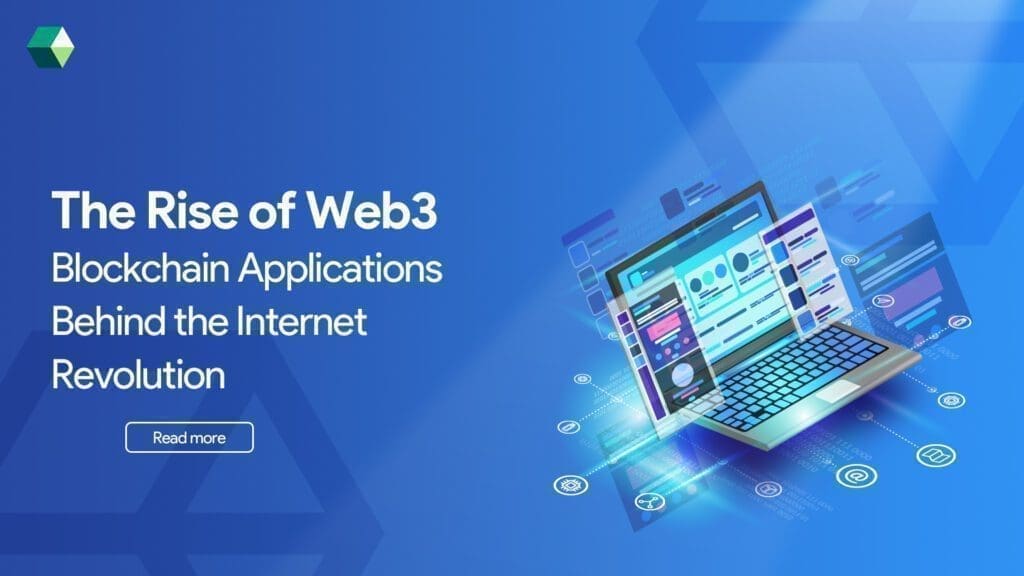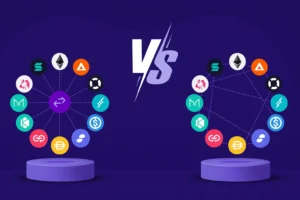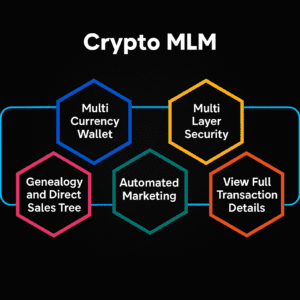
The internet, in its current state, is undergoing a massive transformation. This shift, popularly known as the Web3 revolution, is not just an upgrade of existing web capabilities; it is a complete reinvention of how users interact, share, and control data online. Web3 is fundamentally decentralized, user-centric, and powered by blockchain technology. Unlike Web2, where tech giants hold power over user data, Web3 aims to return that power back to the users. At the heart of this change lies blockchain, a technology that ensures security, transparency, and trust without intermediaries.
This blog explores in-depth the applications, implications, and transformative power of Web3 through the lens of blockchain application. We will look at how different industries are adapting, what opportunities lie ahead, and the technological foundation that makes it all possible.
The Web3 Revolution: A Decentralized Digital Future
The internet is undergoing a massive transformation. This shift, known as the Web3 revolution, is more than just an upgrade—it’s a complete reinvention of how users interact, share, and control data online. Web3 is decentralized, user-centric, and powered by blockchain technology. Unlike Web2, where tech giants hold power over user data, Web3 gives that power back to the users. At the core of this shift lies blockchain, a technology that ensures security, transparency, and trust without intermediaries.
This blog explores the applications, implications, and transformative power of Web3 through the lens of blockchain. We’ll examine how industries are adapting, the opportunities ahead, and the technology that makes it all possible.
The Evolution of the Internet: Web1 to Web3
-
Web1: The Read-Only Web
The earliest iteration of the internet, Web1, was largely static. Websites were composed of read-only HTML pages. Information was distributed in a one-way fashion from publishers to users. There was minimal interaction, and users had no control over content creation or ownership. It was, in essence, a digital library.
-
Web2: The Read-Write Web
Web2 emerged in the early 2000s and marked a significant shift. It allowed users to create, share, and engage with content on platforms like YouTube, Facebook, Twitter, and Instagram. This era was driven by user-generated content and centralized platforms. However, Web2 also brought along critical issues:
- Data centralization: A few tech giants control and monetize user data.
- Privacy concerns: Frequent data breaches and unauthorized data usage.
- Censorship: Central authorities can ban or remove content.
-
Web3: The Read-Write-Own Web
Web3 introduces a decentralized, user-owned web where individuals have control over their data, identity, and assets. It leverages blockchain technology, smart contracts, and token-based economies to build applications that are open, permissionless, and trustless.
Key Characteristics of Web3
- Decentralization: No single point of control; data is distributed across nodes.
- Permissionless Access: Anyone can participate without needing approval.
- Trustless Interactions: Transactions are automated via smart contracts.
- Ownership and Incentives: Users own their digital assets and are rewarded for participation.
- Interoperability: Systems and applications can interact seamlessly.
Blockchain Applications Driving the Web3 Revolution
-
Decentralized Finance (DeFi)
One of the most impactful applications of blockchain in Web3 is DeFi, which eliminates intermediaries like banks and brokers. Instead, it enables peer-to-peer financial transactions using smart contracts. Key components include:
- Decentralized Exchanges (DEXs): Platforms like Uniswap and PancakeSwap allow token trading without central oversight.
- Lending and Borrowing: Protocols like Aave and Compound offer collateralized crypto loans.
- Stablecoins: Tokens like DAI and USDC provide price stability within volatile markets.
- Yield Farming: Users earn interest or tokens by providing liquidity.
DeFi democratizes finance, making it accessible globally, especially for the unbanked population.
-
Non-Fungible Tokens (NFTs)
NFTs are unique digital tokens representing ownership of a specific asset—whether it’s digital art, music, virtual real estate, or collectibles. Use cases include:
- Digital Art: Platforms like OpenSea and Rarible empower artists to sell directly to buyers.
- Gaming: Play-to-earn games like Axie Infinity reward players with NFTs.
- Virtual Real Estate: Metaverse platforms such as Decentraland enable land ownership via NFTs.
NFTs redefine value, giving creators control over their work and enabling secondary market royalties.
-
Decentralized Autonomous Organizations (DAOs)
DAOs are community-governed organizations encoded in smart contracts. They operate without central leadership and use token-based voting systems. Functions of DAOs:
- Project Funding: Communities vote to allocate funds to initiatives.
- Governance: Decisions about protocol upgrades and rules are made collectively.
- Transparency: All transactions and votes are recorded on-chain.
DAOs represent a new model of internet-native cooperation and democratic decision-making.
-
Self-Sovereign Identity
Web3 enables users to control their digital identity using blockchain wallets like MetaMask, Trust Wallet, and Phantom. These wallets act as secure, portable login credentials for dApps (decentralized applications). Benefits:
- Privacy: No need to share personal information with platforms.
- Security: Reduced risk of identity theft.
- Portability: One identity across multiple platforms.
This eliminates the need for passwords and gives users full control over their personal data.
-
Decentralized Storage
Traditional cloud services store data in centralized servers, making them vulnerable to hacks, data loss, and censorship. Blockchain-based storage networks like:
- IPFS (InterPlanetary File System)
- Filecoin
- Arweave
offers distributed file storage where data is replicated across a decentralized network of nodes. These systems ensure resilience, censorship-resistance, and long-term availability.
Real-World Use Cases of Web3
-
Gaming and Virtual Worlds
Web3 is changing the way we play games. In Play-to-Earn games like Axie Infinity and The Sandbox, you can earn real money just by playing. With Digital Ownership, you fully own your game items, like characters or tools—you can keep them, sell them, or trade them. And with Interoperable Avatars, you can use the same character in many games. All this is possible because of smart blockchain application and advanced blockchain app development.
-
Social Media and Content Platforms
Web3 is giving more power to content creators. Platforms like Lens Protocol and Mirror let creators earn money directly from fans, with no middleman. Also, there is No Censorship—your content stays online even if a platform goes down. This freedom is made possible through strong blockchain app development, making social platforms better and fairer.
-
Supply Chain Transparency
Blockchain helps us know where products come from. A blockchain application can track every step a product takes—from where it was made to where it gets delivered. This helps prove it’s real (Authenticity) and easy to trace if there’s a problem (Traceability). It also builds trust. Many industries like food and fashion now use blockchain app development to make supply chains clear and honest.
-
Healthcare
Web3 is making healthcare safer. A blockchain application lets patients control who can see their Medical Records. This means better privacy and security. It also makes clinical research more open and helps doctors work together. Thanks to secure blockchain app development, health data is now easier to manage and more trustworthy.
-
Education
Blockchain is improving education too. Schools and colleges can issue secure, digital certificates that no one can fake. Employers can quickly check if someone’s degree is real. This is done using blockchain applications that are easy to use and safe. Thanks to blockchain app development, learning and hiring become faster and more reliable.
Challenges in Web3 Adoption
While Web3 is promising, it faces significant challenges:
- >High traffic leads to congestion and gas fees. Layer 2 solutions like Arbitrum and Optimism are helping scale operations.
- Wallets, seed phrases, and transaction fees create a steep learning curve. Improving UX is crucial for mass adoption.
- Governments are still shaping crypto regulations, which can affect DeFi, NFTs, and overall innovation.
- Smart contract bugs, scams, and hacks require better auditing, user education, and proactive safety measures.
- Proof-of-Work consumes high energy. Ethereum’s shift to Proof-of-Stake marks progress in reducing Web3’s carbon footprint.
The Future of Web3
Web3 is growing fast, and it’s changing the internet as we know it. New ideas like cross-chain connections, decentralized AI, on-chain voting systems, social networks built on blockchain, and private token-based communities are leading the way. As the tech improves and more people start using it, Web3 will become a natural part of our everyday lives. We’ll see more people using crypto wallets, easily interacting with decentralized apps (dApps), and even jobs becoming part of decentralized gig platforms. Important areas like education, healthcare, and government services may also move to the blockchain.
A big reason this is all possible is because of Custom Blockchain Development. Through Custom Blockchain Development Services, businesses can build their own unique blockchain systems that fit their needs—whether it’s for better security, smoother operations, or more control. Web3 isn’t just about new tech—it’s about giving power back to users, being more transparent, and making the digital world open to everyone, everywhere.
Join the Web3 world – We’ll build it for you.
The rise of Web3 is more than just a trend—it’s a movement that’s changing how we connect, create, and interact online. Built on the foundation of blockchain technology, Web3 is all about decentralizing data, shifting power from big corporations to individuals, and giving users true ownership of their digital lives. Whether you’re a developer, investor, creator, or simply curious, now is the perfect time to dive into the world of Web3. Get involved, use the tools, join the communities, and help shape a more open and fair digital future.
If you’re ready to build your own Web3 app or want to explore how blockchain can transform your business, connect with Nadcab Labs. As leaders in Blockchain Development Solutions, we specialize in turning bold ideas into reality with custom-built, secure, and scalable technology. Welcome to the future of the internet. Welcome to Web3.







